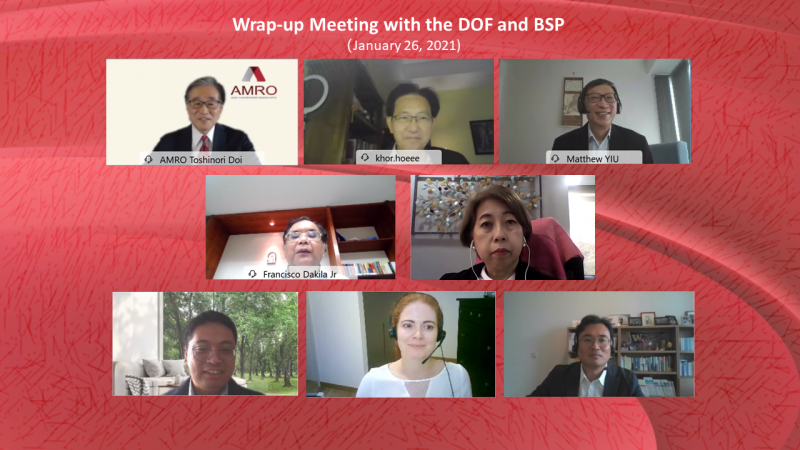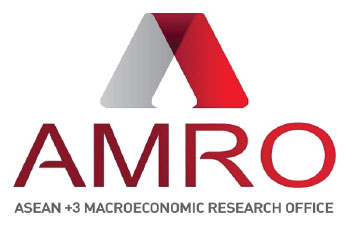
Top row (from left to right): AMRO Director Toshinori Doi, AMRO Chief Economist Hoe Ee Khor, AMRO Lead Economist Siu Fung Yiu.
Middle row (from left to right): Bangko Sentral ng Pilipinas Deputy Governor Francisco G. Dakila, Jr., Department of Finance Assistant Secretary Maria Teresa S. Habitan
Bottom row (from left to right): AMRO Economist Zhiwen Jiao, AMRO Economist Anne Oeking, AMRO Senior Economist Byunghoon Nam
SINGAPORE, January 29, 2021 –The disruptions brought about by the COVID-19 pandemic have plunged the Philippine economy into the deepest recession in more than two decades. The authorities’ unprecedented policy responses have provided indispensable support to households, businesses and financial institutions. However, further policy support and a faster rollout of vaccines are essential for the Philippine economy to secure a more solid recovery. This is according to the preliminary assessment by the ASEAN+3 Macroeconomic Research Office (AMRO) after its virtual Annual Consultation with the Philippine authorities from January 11 to 26, 2021.
The mission was led by AMRO Lead Economist, Dr. Siu Fung Yiu. AMRO Director, Mr. Toshinori Doi, and Chief Economist, Dr. Hoe Ee Khor participated in policy meetings. The consultation focused on the development of the COVID-19 pandemic and its adverse impact on the Philippine economy, key risks and challenges, and policy responses to revive and transition the economy to the post-pandemic new normal.
Economic Developments and Outlook
“The Philippine economy contracted by 9.5 percent in 2020 as a result of the disruptive impact of the COVID-19 pandemic,” said Dr. Yiu. “As the recovery remains fragile and is at its early stage, the government should maintain sufficient policy support to ensure a robust economic recovery while safeguarding against potential macroeconomic and financial risks. We expect the economy to grow by 7.4 percent in 2021, accelerating to 7.8 percent next year,” said Dr. Yiu.
The collapse of domestic demand was broad-based and particularly acute in sectors that need physical contact and close engagement. The unemployment rate remained elevated at 8.7 percent in October, albeit much lower than in April when containment measures were first introduced. Despite some supply disruptions from the pandemic and a series of strong typhoons, inflation has remained low and stable, within the target range of 2-4 percent.
The current account shifted to a large surplus of USD8.7 billion in the first three-quarters of 2020 or 3.4 percent of GDP. Moreover, capital flows became more balanced following a large outflow in the first quarter, partially supported by the government’s large external borrowings. As a result, the overall balance of payment improved substantially and international reserves rose to a record high of USD109.8 billion in December 2020, which is more than sufficient to meet the country’s short-term external funding needs.
Looking ahead, the Philippine economy is expected to continue to recover, as more restrictive policies are lifted, and confidence is restored by mass vaccination and continued policy support.
Risks and Vulnerabilities
The Philippine economy continues to face multiple downside risks and challenges in its recovery path, including a prolonged wave of the pandemic and a slower-than-expected global recovery. Businesses face potential financial distress with implications for lower potential growth due to the scarring effects of a prolonged downturn.
Dominated by the service-oriented sectors and micro, small and medium enterprises (MSMEs), the economy is vulnerable to the COVID-19 shocks. Effective policy transmission faces several practical challenges that may be improved with greater financial inclusion. As such, the Philippines is likely to experience some reversal of social-economic gains.
Policy Responses
The Philippine government has deployed a wide array of measures to contain the pandemic, including the most stringent and longest lockdowns.
The government’s four-pillar strategy is critical for containing the pandemic, mitigate the adverse impact, and revive the economy. The fiscal deficit is expected to widen to 7.6 percent of GDP in 2020 but the fiscal stimulus is relatively modest. The fiscal policy in 2021 is moderately expansionary and supportive of the recovery. However, considering that the recovery is still nascent, further fiscal support would be critical if the growth momentum is weaker than expected and the economy were to falter.
Monetary and regulatory policy responses have been swift and effective in easing monetary conditions and ensuring ample liquidity in the financial system. More efforts should be placed on enhancing the effectiveness of monetary transmission and supporting credit expansion. The Bangko Sentral ng Pilipinas (BSP) should collaborate with other government agencies to offer banks greater incentives to increase lending to the business sector, especially MSMEs.
The development of financial risks should be closely monitored, while the intervention and resolution framework should continue to be strengthened. Likewise, the withdrawal of regulatory forbearance needs to be cautious. Although the economy has entered the recovery phase, the deterioration of asset quality is still ongoing. The typical inverted U-shaped trajectory of non-performing loans indicates that the efforts of resolving the problem assets can stretch beyond the current policy cycle. It is important for the BSP to coordinate closely with its stakeholders and other government agencies when deciding on the extension or withdrawal of relief measures to avoid a cliff effect.
Structural policies and reforms are needed to enhance the resilience of the economy to shocks and facilitate the transition to the post-pandemic new normal. The government’s efforts to promote digitalization, invest in infrastructure, and improve the “doing business” environment, will facilitate the process.
AMRO’s mission team would like to express its deep appreciation to the Philippine authorities and other participating organizations for their cooperation and candid exchange of views. AMRO wishes to express our appreciation for the strong support and coordination from the Philippine authorities for the excellent arrangement that has made this virtual mission possible.
—
About AMRO
The ASEAN+3 Macroeconomic Research Office (AMRO) is an international organization established to contribute toward securing the macroeconomic and financial stability of the ASEAN+3 region, which includes 10 members of the Association of Southeast Asian Nations (ASEAN) and China; Hong Kong, China; Japan; and Korea. AMRO’s mandate is to conduct macroeconomic surveillance, support the implementation of the regional financial arrangement, the Chiang Mai Initiative Multilateralisation (CMIM), and provide technical assistance to the members.
